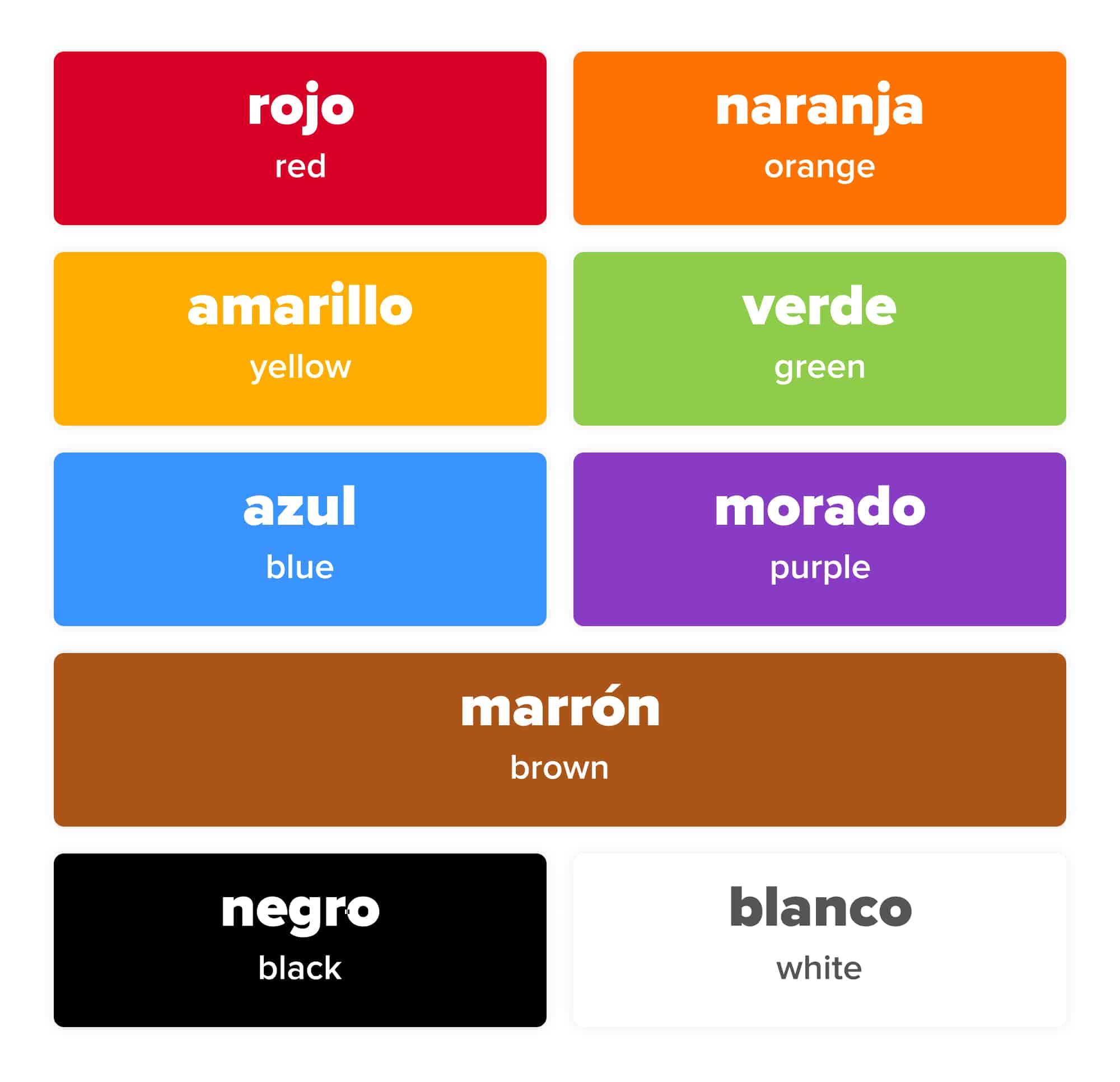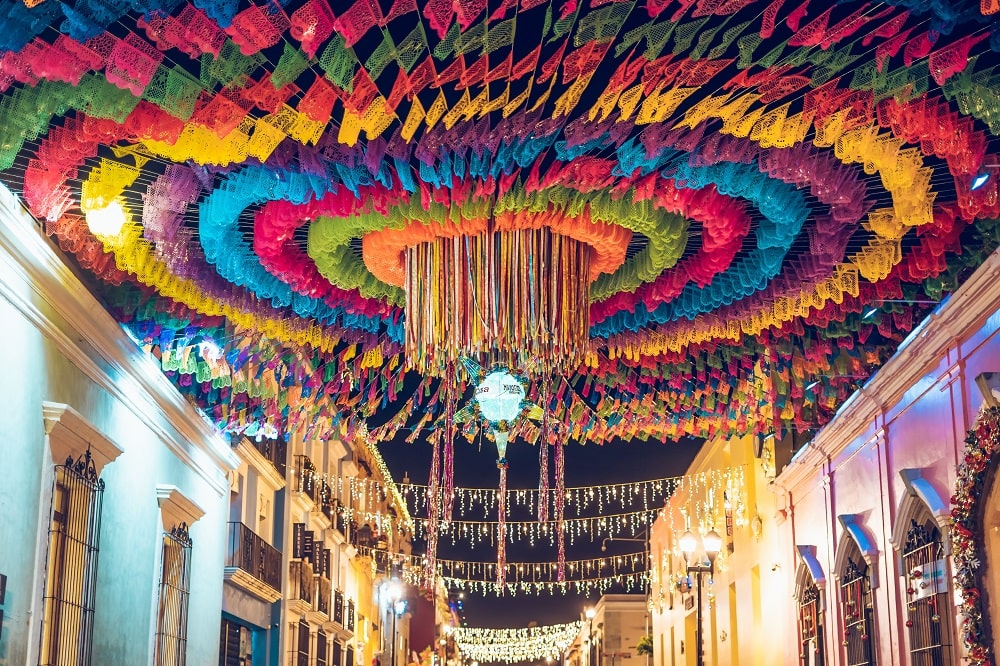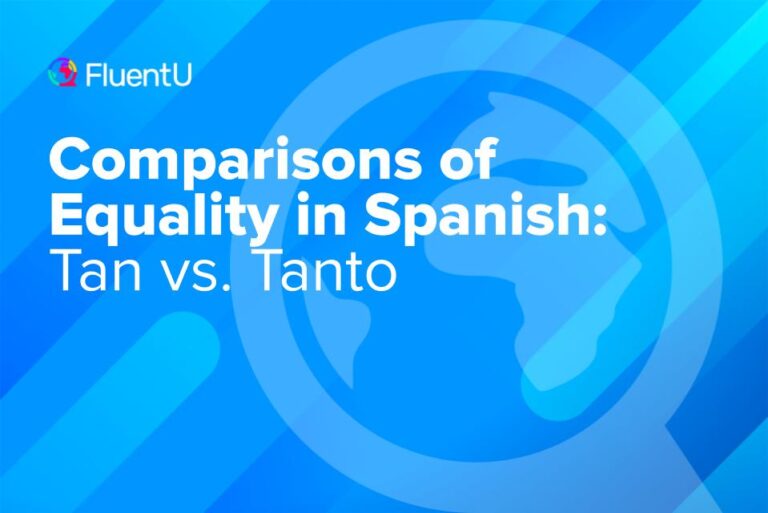Colors in Spanish and How to Discuss Them

I’d guess that colors were some of the first words you learned in Spanish. It’s not hard to see why—color words are essential for lots of tasks, from writing creatively and understanding poetry, to indicating objects and expressing likes and dislikes.
This article will show you some of the most common Spanish color words, as well as the most important rules for using them.
Download: This blog post is available as a convenient and portable PDF that you can take anywhere. Click here to get a copy. (Download)
Most Common Colors in Spanish

Rojo — Red
Variations: Rojo changes to roja when the noun it’s describing is feminine.
- Rosado / rosa — Pink
- Escarlata — Scarlet
- Rubí — Ruby
- Granate — Maroon
- Magenta — Magenta
- Caoba — Mahogany
Naranja — Orange
Variations: Anaranjado/a is more common in Spain. You’ll likely hear naranja in Latin America, and it doesn’t change with gender.
- Durazno (Latin America) / melocotón (Spain) — Peach
- Ámbar — Amber
- Albaricoque — Apricot
- Coral — Coral
Amarillo — Yellow
Variations: Amarillo changes to amarilla when the noun it’s describing is feminine.
- Limón — Lemon
- Dorado / dorada — Gold
- Diente de león — Dandelion
- Amarillo mostaza / mostaza — Mustard
- Crema — Cream
- Rubio / rubia — Blonde
Verde — Green
Variations: Verde never changes, despite the gender of the noun it describes.
- Verde esmeralda — Emerald
- Verde olivo — Olive
- Lima — Lime
- Pera — Pear
- Menta — Mint
- Cerceta / verde azulado — Teal
Azul — Blue
Variations: Azul also stays the same no matter the noun’s gender.
- Turquesa — Turquoise
- Azul marino — Navy
- Azul cielo / azul celeste — Sky blue
- Azul bebé — Baby blue
- Azul real — Royal blue
Morado — Purple
Variations: Morado changes to morada when it describes a feminine noun. Its alternative name púrpura, on the other hand, stays the same, although it isn’t all that common these days.
Café — Brown
Variations: Marrón is more common in Spain. Café is more common in Latin America. Neither change gender.
- Castaño — Chestnut
- Chocolate — Chocolate
- Castaño rojizo — Auburn
- Bronceado — Tan
- Beige — Beige
Negro — Black
Variations: Negro becomes negra when the noun is feminine.
- Negro azabache — Jet black
- Negro intenso — Pitch black
- Ébano — Ebony
- Carbón — Coal
- Ónix — Onyx
Blanco — White
Variations: Blanco changes to blanca when the noun is feminine.
- Plateado — Silver
- Gris — Gray
- Marfil — Ivory
- Blanquecino — Off-white
- Perla — Pearl
- Alabastro — Alabaster
Colors in Spanish to Describe People
Eye Color
- Ojos oscuros — Dark eyes
- Ojos claros — Light eyes
- Ojos azules — Blue eyes
- Ojos castaños / ojos cafés — Brown eyes
- Ojos color avellana — Hazel eyes
- Ojos verdes — Green eyes
Skin Color
- Bronceado / bronceada — Tan
- Pálido / pálida — Pale
- Piel morena — Dark skin
- Piel clara — Light skin
- Piel sin impurezas — Clear skin
Hair Color
- Rubio / rubia — Blonde
- Moreno / morena — Brunette
- Pelirrojo / pelirroja — Redhead
- Canoso / canosa — Gray-haired
- Cabello teñido — Dyed hair
Words to Describe Colors in Spanish
- Colorido / colorida — Colorful
- Claro / clara — Light
- Oscuro / oscura — Dark
- Brillante / vibrante — Bright
- Vívido / vívida — Bright, vivid
- Llamativo / llamativa / intenso / intensa — Bold
- Opaco / opaca — Dull
- Neón — Neon
- Pastel — Pastel
- Cálido / cálida — Warm
- Frío / fría — Cool
Grammar Rules for Using Colors in Spanish Sentences
You may already know some of these rules, so here’s a quick refresher. However, if you’re not super familiar with these, with some practice you’ll have them down pat.
You can speed up that process by exposing yourself to lots of native Spanish content, so you can hear how native speakers talk about colors. You can find native content on YouTube, or a language learning program like FluentU.
FluentU takes authentic videos—like music videos, movie trailers, news and inspiring talks—and turns them into personalized language learning lessons.
You can try FluentU for free for 2 weeks. Check out the website or download the iOS app or Android app.
P.S. Click here to take advantage of our current sale! (Expires at the end of this month)

Pay attention to word order
Like most Spanish adjectives, the color words go after the noun they describe.
For example:
El coche azul. (The blue car. Literally, “the car blue.”)
Watch out for number and gender
When using the color words as adjectives, you must make the colors agree with the number and gender of the noun.
For example, el sofá (the sofa) is a singular, masculine noun. Las actrices (the actresses) is a plural, feminine noun.
As with all Spanish adjectives, you must ensure that the color words agree with the noun they describe.
Los ojos azules. (The blue eyes.)
Las casas blancas. (The white houses.)
A color that doesn’t end in o won’t change its spelling
Gender change rules don’t always apply, as any color that doesn’t end in an o won’t change its spelling.
For example: verde (green), azul (blue) and rosa (pink).
You usually use ser with colors
When describing what color something is, such as in a sentence like “The phone is black,” you almost always use the verb ser.
El teléfono es negro. (The phone is black.)
Las botellas son amarillas. (The bottles are yellow.)
The verb estar (to be) generally refers to temporary states of being. There are rare cases in which you might need to use estar to describe the color of something.
Here’s an example: If you wanted to say that today the sky is gray because of an impending rainstorm, you could use the verb estar (since it’s normally blue):
El cielo está gris. (The sky is gray.)
Use “de color” to simplify things
Another way to describe color in Spanish is to say that something is de color… (the color…).
With this construction, you’ll always use the masculine, singular version of the color—regardless of the noun!
Las camisetas son de color rosa. (The shirts are the color pink.)
Colors don’t change gender in the noun + color + adjective/noun formula
When you combine noun + color + adjective/noun, the color and adjective/noun don’t change genders.
This means that no matter what gender or number the main noun is, the color and the adjective/noun will remain in the masculine singular form.
For example:
El libro azul oscuro. (The dark blue book.)
La camisa azul oscuro. (The dark blue shirt.)
Los libros azul oscuro. (The dark blue books.)
Las camisas azul oscuro. (The dark blue shirts.)
Colors can be nouns
Colors can also act as nouns, not just adjectives.
When a color functions as a noun, it will always be masculine, no matter what.
El rosa es mi color favorito. (Pink is my favorite color.)
Los naranjas te quedan muy bien. (Orange colors suits you very well.)
Colors in Spanish Practice Quiz
Now that you know the most important colors in Spanish, it’s time to practice them! By practicing the colors, you’ll be able to start using them in your own Spanish conversations to add extra information.
1. Me gustan tus zapatos (___). (I like your red shoes.)
2. No encuentro mi falda (___). (I can’t find my black skirt.)
3. El (___) es mi color favorito. (Yellow is my favorite color.)
4. Tengo los ojos (___). (I have green eyes.)
5. El (___) es un color cálido. (Orange is a warm color.)
6. Mi abrigo es de color (___). (My coat is pink.)
7. No puedo quitar una mancha de mi camisa (___). (I can’t remove a stain on my white shirt.)
8. Mi amiga tiene un coche (___). (My friend has a light blue car.)
9. Hay tantas casas (___) en México. ¡Son espectaculares! (There are so many colorful houses in Mexico. They are spectacular!)
10. Parece que va a llover pronto. El cielo está (___). (It looks like it’s going to rain soon. The sky is gray.)
Answers:
1. Rojos
2. Negra
3. Amarillo
4. Verdes
5. Anaranjado/naranja
6. Rosado/Rosa
7. Blanca
8. Azul claro
9. Coloridas
10. Gris
The Spanish colors are simple to learn and use once you get the hang of a few rules.
And they improve your ability to express yourself in Spanish, whether it be in a supermarket or in a poetry workshop.
So, go forth and add color to your Spanish!
Download: This blog post is available as a convenient and portable PDF that you can take anywhere. Click here to get a copy. (Download)
And One More Thing…
If you've made it this far that means you probably enjoy learning Spanish with engaging material and will then love FluentU.
Other sites use scripted content. FluentU uses a natural approach that helps you ease into the Spanish language and culture over time. You’ll learn Spanish as it’s actually spoken by real people.
FluentU has a wide variety of videos, as you can see here:

FluentU brings native videos within reach with interactive transcripts. You can tap on any word to look it up instantly. Every definition has examples that have been written to help you understand how the word is used. If you see an interesting word you don’t know, you can add it to a vocab list.

Review a complete interactive transcript under the Dialogue tab, and find words and phrases listed under Vocab.

Learn all the vocabulary in any video with FluentU’s robust learning engine. Swipe left or right to see more examples of the word you’re on.

The best part is that FluentU keeps track of the vocabulary that you’re learning, and gives you extra practice with difficult words. It'll even remind you when it’s time to review what you’ve learned. Every learner has a truly personalized experience, even if they’re learning with the same video.
Start using the FluentU website on your computer or tablet or, better yet, download the FluentU app from the iTunes or Google Play store. Click here to take advantage of our current sale! (Expires at the end of this month.)











